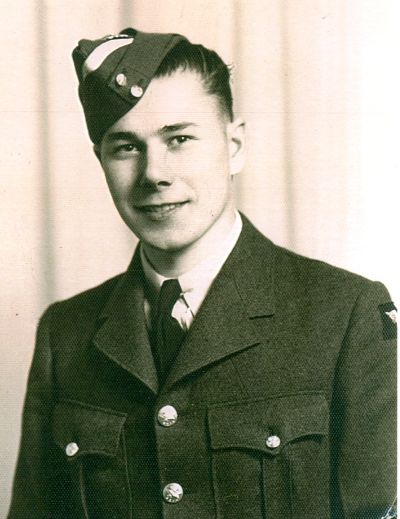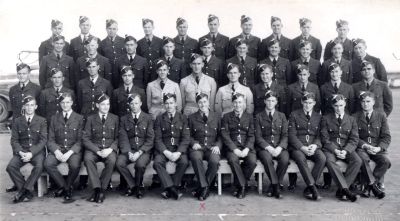George Stanton Gale - World War Two Pathfinder

Everyone that walked through the recruiting centre doors wanted to be a fighter pilot and very few would make it. Only a few that were recruited were even selected for training. George was one of those few. Three days later he was on a train for the Commonwealth Air Training Plan School at Penhold, Alberta where his medical and intake was completed. On August 9th, 1941 he arrived in Edmonton at the #4 Initial Training School. He passed the course and then moved across the airfield to the #16 Elementary Flight Training School. In October of 1941 he was informed that unfortunately, he was not being moved on for further pilot training. Undeterred George headed for the Air Gunnery School at Trenton, Ontario. He graduated on March 27th, 1942 receiving his Air Gunners Brevet (wings). On the 29th of April he arrived in Halifax to board a boat for England.
 <>
<>
On August 8th, 1942, after arriving in England and taking further training he was posted to #14 Operational Training Unit at Cottesmore, England. Here he honed his air gunnery skills and also learned about his role as a member of the aircrew on a Bomber. On November 8th, 1942 George was flying as the tail gunner (the most dangerous position in a bomber as the enemy usually attacked from the rear) on a Handley Page Hampden when it crashed at Saltby, England. George was injured and taken to hospital. Upon his release he wrote the following report:
“I have the honour to report that I was rear gunner in Hampden 4100(N) piloted by Sgt East on the night of November 8th, 1942. On our return from a Bullseye exercise having been given permission to land, Sgt East ordered us to prepare for the landing. Everyone was in correct position and we appeared to be on the approach when the port engine cut. There was a sudden swing to port and we appeared to be side slipping a few feet from the ground. Sgt East managed to straighten and level out to a certain extent. We hit the ground and swung, everyone being thrown to the side of the aircraft. I was able to help the navigator, Sgt Webb, get clear and to a safe distance from the aircraft, he having broken his leg.”
Early in 1943 George was assigned to his Squadron, and what an assignment it was. At the outset of the war Royal Air Force Bombers were having a very difficult time accurately navigating to and effectively hitting their targets. Heavy losses early in the war had resulted in the RAF switching to night bombing in the dark. The key to success was experienced bomb crews who could guide the rest of the planes to the target. This resulted in the creation of the “Pathfinder Force”. The very best squadrons were chosen for this duty. Like so many honours, this elite status also came with increased responsibility and danger. The Pathfinders were to drop flares so that the following squadrons could get a visual fix on their target. Unfortunately, this also significantly helped the German Anti-Aircraft gunners find the Pathfinders. The Royal Air Force web page on Bomber Command described the Pathfinders:
“The gallantry of the PFF is legendary, and its contribution to the war effort immense, perfecting as it did techniques for precision main force bombing. Probably the greatest of many successes was its part in the sustained Battle of the Ruhr.”
The first Squadron in the RAF to receive four engine bombers, the Short Stirling, was 7 Squadron. 7 Squadron was also chosen to be one of the first Pathfinder Squadrons. George was assigned to 7 Squadron, operating from RAF Oakington, as a rear gunner on Stirlings.
What was known as the Battle of the Ruhr began in late March of 1943. The Ruhr region was the heart of Germany’s industrial production and all efforts to knock out the manufacturing of tanks, planes and guns was to be made. On the night of 8/9 April 1943 the RAF launched 392 bombers to attack the town of Duisberg, Germany. The mission was made up of 156 Lancasters, 97 Wellingtons, 73 Halifaxes, 56 Stirlings and 10 Mosquitos. 7 Squadron took off from Oakington at 2119 hrs for what was planned to be a five hour and thirty minute flight. George was in his usual position as the rear gunner in Stirling Mk 1 Serial number R9199, letter codes MG-F. The rest of the crew were:
Flying Officer L J Stewart – Pilot (Canada)
Pilot Officer GMM DeMeillac – Co-Pilot (Trinidad)
Flying Officer AH Jackson – Navigator (Canada)
Sgt GM Boardman
Sgt RS Hamilton-Fox
Sgt V Walters
Sgt R Wilson
There was a lot of fog and cloud that evening which made the bomb run very difficult and many of the squadrons had trouble locating the target. It is not known exactly what happened to George and his crew. It is likely that they were hit by Anti-Aircraft fire and tried to make it back to England but crashed into the sea. No trace of the plane or any crew were ever found. Losses for the raid included 19 aircraft - 7 Wellingtons, 6 Lancasters, 3 Halifaxes, and 3 Stirlings.
By March of 1943 George’s father, at 56 years old, had joined the RCAF as had his brother Fred. His brother Vern would also eventually serve in the RCAF. Bill learned of George’s death while posted at Dauphin, Manitoba.
After the war, George’s sister Emma wrote:
“When war broke out he joined the Air Force in Regina and went overseas in June, 1942, as an Air Gunner. He was always very grateful for packages from home and often remarked that he had forgotten pickles could taste so good – better than cabbage and sausage."
In 1998 his brother Fred wrote:
“George loved to fight, and he was a tough, clean fighter. Every fight I witnessed he always won. He kept on fighting until he died.”
“In the air force he volunteered to be a member of the Pathfinder crew whose job it was to take a lone plane to a designated city and drop flares to light up the targets for the hundreds of night bomber who were only minutes behind. In truth it was a suicide squad, for once they turned night into day, the anti-aircraft guns and Messerschmitt fighter planes used them for target practice. George helped light up about five cities, including Berlin.” George was many things to many people, but to me he was one of Canada’s unsung heroes. I still miss him after fifty-five years.”
George has no grave. His name is inscribed on the Air
Forces Memorial at Runnymede, England along with over 20 000 of his comrades
whose bodies were never recovered.
To contact George Gale's family please email Karen Dyer